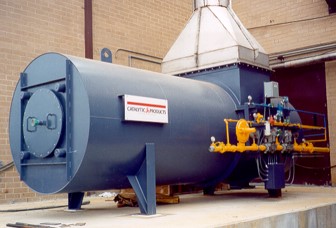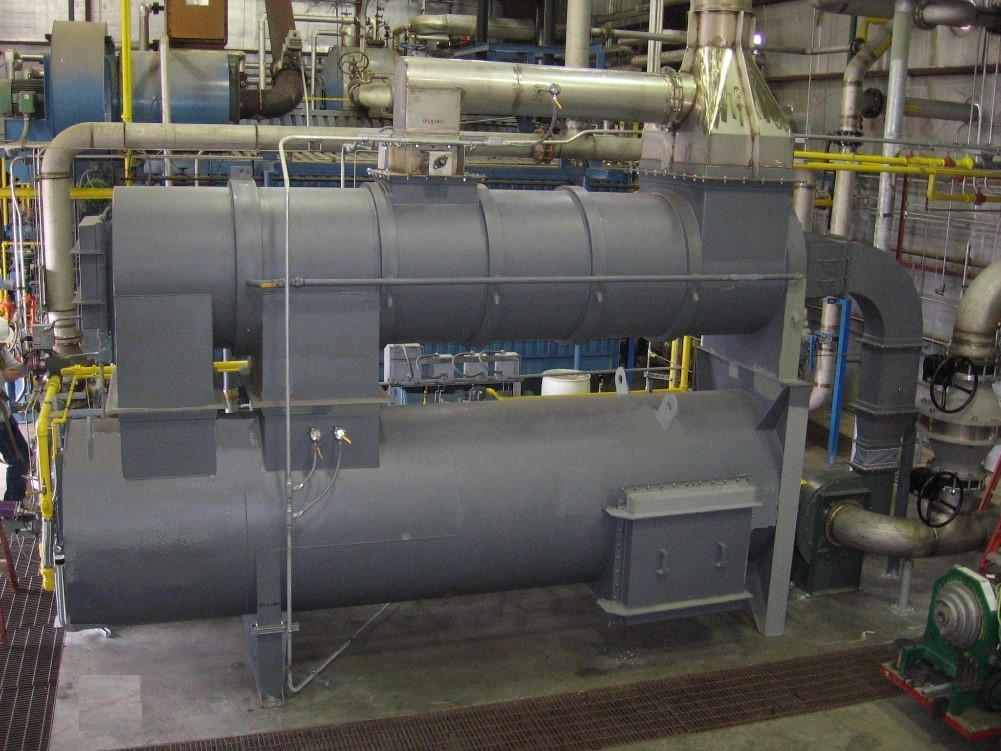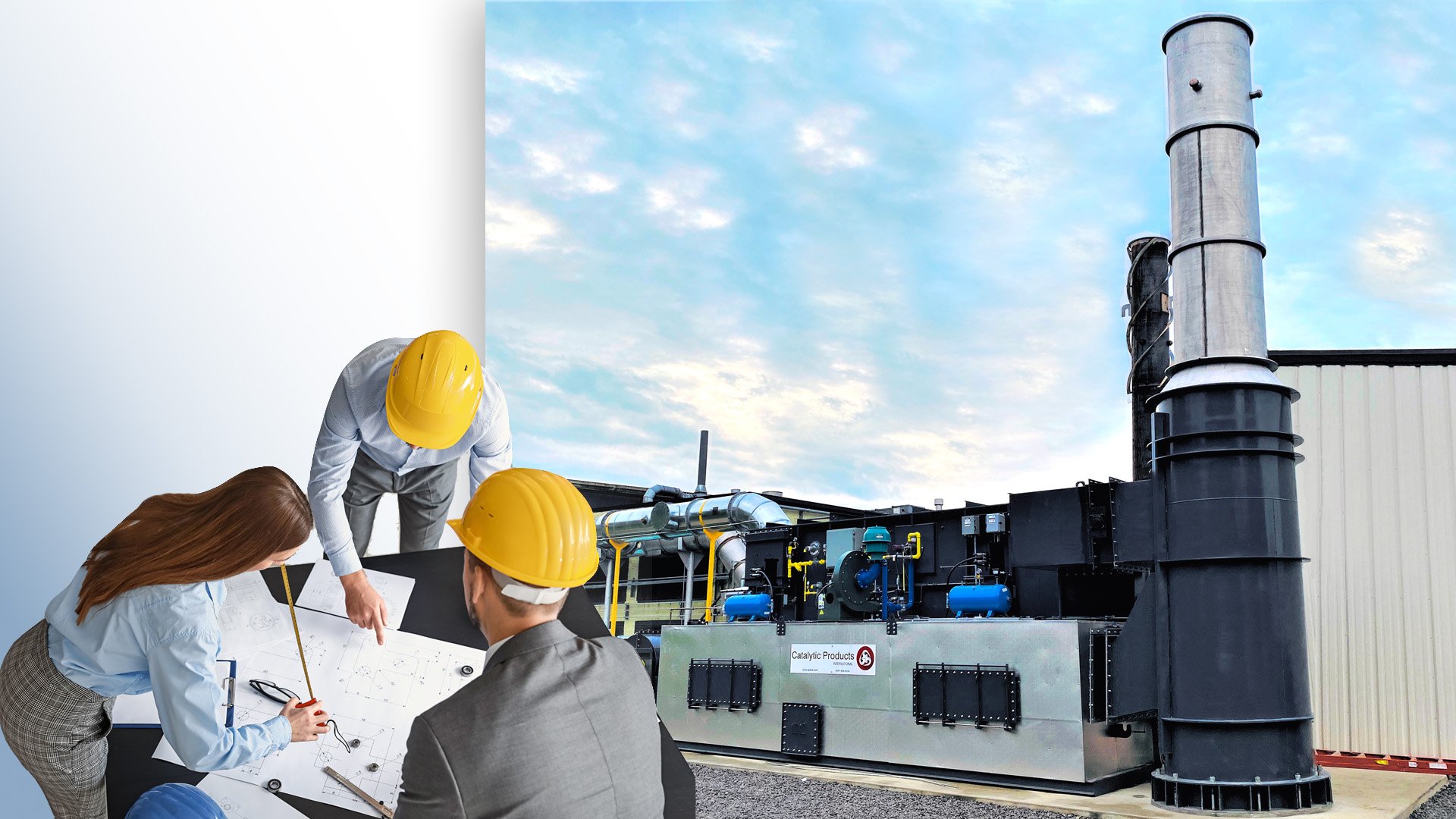An oxidizer is not something that business owners address by saying, “Let’s do the right thing for the environment and install an oxidizer!” In fact, the scenario is more likely to be “We need to increase productivity (always a good thing!), but that will put us over our annual emissions limits. Do we know what we will need? Where do we start? Who can help us?”
Table of contents
- Considerations Before Selecting an Oxidizer for VOC Control
- Scenario 1: Regenerative Thermal Oxidizer
- Scenario 2: Direct Fired Thermal Oxidizer
- Scenario 3: Thermal Recuperative Oxidizer
- Scenario 4: Catalytic Oxidizer
Considerations Before Selecting an Oxidizer for VOC Control
There are many factors that impact whether an oxidizer is required. How do you know which control device is correct for your application? As mentioned in Part 1 of our blog series “How Long Does it Take to Build an Oxidizer?”, part of the client buying process is a technology review. It is important for the plant's engineering staff to discuss the application data with potential suppliers. This will help determine options for the customer to meet or exceed their environmental goals or outcomes. The oxidizer supplier will then be able to direct the customer to the appropriate Best Available Control Technology (BACT) or Maximum Available Control Technology (MACT).
Typical application data that should be discussed includes:
- Process Type
- Process Exhaust Rate (Air Flow)
- Exhaust Temperature
- VOC type
- VOC loading (lbs/hr.)
- Particulate (Y/N)
- Particulate Size
Let's take a closer look at some of this data and how it affects the decision of which oxidizer to use:
Air Flow: This is measured in Standard Cubic Feet per Minute (SCFM), with the volumetric flow rate of the process gas corrected to "standardized" conditions of temperature and pressure. This represents a fixed number of moles of gas regardless of composition and actual flow conditions.
Note: air flow can also be measured as Nm3/h (Normal Meters Cubed per Hour).
(Process) Temperature: This can range from ambient air temperature (the overall temperature of the outdoor air that surrounds us) to very high process temperatures greater than 500° F.
VOC Loadings: The amount of volatile organic compounds (VOCs) will need to be identified in both the worst case scenario (highest) concentration, and normal operation scenarios. VOC concentrations can play a huge role in the operating expense (OpEx), such as electrical and natural gas usage, consumable parts, and maintenance, of the equipment. For example, the operating cost for a thermal oxidizer might be higher than a regenerative thermal oxidizer due to the natural gas usage required. However, it might be possible to recuperate some of the cost by installing a heat recovery system as well. The capital expense (CapEx), large equipment purchases, may show a quick payback by lowering the OpEx.
VOC concentration is also evaluated for safe operation of the system. Most of the time the VOC concentration is converted to a percentage of the Lower Flammable Limit (LFL) in the exhaust stream to be treated. The LFL is the lowest concentration (percentage) of a gas or vapor in air capable of producing a flash of fire in presence of an ignition source (arc, flame, heat).
Required VOC Destruction Rate Efficiency (DRE): This number is typically >95% and may be as high as >99%.
Here are some additional questions that we ask to determine the best oxidizer for a customer's process:
Does your process contain contaminants?
Silicone, for example, can build up on heat exchanger tubes, burners, and fans, and it can create maintenance nightmares if the wrong technology is chosen. Silicone will also mask the catalyst – which makes a catalytic oxidizer a poor technology choice (at times) for an application that can contain silicone.
Does your process contain particulates?
Processes such as tape manufacturing and web coating can contain particulates, like silicone, that can build up throughout the system, causing maintenance headaches and decreased oxidizer performance. In some cases, particulates can be eliminated by placing a filter in front of the oxidizer system, and this type of filter can be used regardless of the technology chosen. However, in some instances, the particulate is actually formed inside the combustion chamber of the oxidizer, which adds several more layers of consideration when selecting the correct control device.
Is the exhaust stream corrosive?
Does the air stream anything acidic which can be corrosive to the areas of the oxidizer that it comes in contact with? Special care needs to be taken into consideration when choosing construction materials and special coatings to prevent material failures.
How much space have you allotted for your new oxidizer?
If you are incorporating a large piece of equipment at the end of a process line in a new facility, space may not be an issue. But if you are trying to maximize every square inch of the building you have been at for 40 years, you may face some interesting challenges, and space consideration may be an influence on the decision of which technology would best suite your needs.
Identifying Your Ideal Oxidizer
| Regenerative Thermal Oxidizer (RTO) | Direct-Fired Thermal Oxidizer | Recuperative Thermal Oxidizer | Catalytic Oxidizer | |
| Process Gas Volume | 2,000 SCFM - 80,000 SCFM | 100 SCFM -10,000 SCFM | 500 SCFM - 50,000 SCFM | 500 SCFM - 30,000 SCFM |
| VOC Concentrations | 0%-15% LEL | >25% LEL | 10%-25% LEL | 0%-15% LEL |
| Particulate Loading | Clean or low particulate |
Presence of particulate |
Presence of particulate | No particulate |
| Process Gas Temperature | < 500 o F | > 600 o F | < 600 o F | < 800 o F |
Scenario 1: Regenerative Thermal Oxidizer (RTO)
Regenerative thermal oxidizers are typically utilized for processes that have:
- Process gas volume ranging from 2,000 SCFM to 80,000 SCFM for one system. Larger air volumes (>100,000 scfm) can be achieved with tandem configuration or combining with a Rotary VOC Concentrator.
- VOC concentrations ranging from 0% to 15% of the LEL (lower explosive limit)
- Clean or low particulate in the process gas or after combustion of the VOC
- Process gas temperatures up to 500° F
A regenerative thermal oxidizer utilizes a ceramic media as the primary heat exchange medium. A booster fan draws VOC-laden exhaust from your process into the system. From there, VOCs are directed into one of the system's regenerators (an internally insulated vessel containing ceramic media).
The contaminated gases are passed through the first regenerator, where energy is transferred from the ceramic media to the gas to elevate the process gas temperature. This elevated temperature approaches the ignition level for most VOCs. The stream exits the ceramic bed and travels through the internally lined combustion chamber, where minimal heat is added to the oxidized VOC gases. The oxidized gases are then directed to the second regenerator ceramic bed to absorb the heat energy from the hot oxidized gases.
After a fixed amount of time, the gases are reversed through the system, where the regenerator bed that was heating the VOC-laden process air will now accept air from the combustion chamber. This regenerator will now be used to preheat VOC-laden process gas. This continues the energy transfer and oxidation cycle of the process gas before it is released to the atmosphere.
Advantages of RTOs include:
- The lowest operating costs of all control devices. Because the ceramic media is a very efficient heat exchanger allowing an RTO to provide thermal rate efficiencies up to 97%.
- High air flow capacity.
- Competitive capital costs.
- Low NOx and CO emissions.
There are a couple of drawbacks to RTO systems:
- Plugging – the primary heat exchanger media is susceptible to plugging with high particulate loadings.
- Large footprint/heavy loads – these systems may present some installation challenges.
- More moving parts - valve sealing is critical to operation of the system in the long term, resulting in the potential need for frequent maintenance.
The capital investment for an RTO includes the equipment cost, the cost of auxiliary equipment (e.g. ductwork, product options), and all direct and indirect installation costs. The higher capital costs of these units can be substantially offset by the substantial savings in auxiliary fuel costs. The cost of an RTO is influenced by the exhaust stream volumetric flow rate, VOC loading and desired destruction rate efficiency.
In addition to the oxidizer, there are auxiliary heating systems, such as secondary air to air recovery, air to water recovery, air to oil recovery, or a closed loop direct recirculation process that can be used to further reduce operation costs.
Because of the low capital and operation cost benefits mentioned above, most companies tend to gravitate towards a RTO immediately, but these devices require special scrutinizing of the exhaust stream to be processed. High VOC loadings, the need for process heat recovery, and, more importantly, particulate-laden airstreams may drive educated consumers to different products that may be much more beneficial to the process operation in a long term evaluation.
Learn more about Regenerative Thermal Oxidizers
Scenario 2: Direct Fired Thermal Oxidizer (DFTO)
Direct thermal oxidizers are typically utilized for processes that have:
- Low inlet volume (the cutoff is typically in the range of 100 to 10,000 standard cubic feet per minute (SCFM)
- Very high concentration of VOCs (greater than 25% of the LEL (lower explosive limit)
- Presence of particulate in the process gas
- High process gas temperature (typically greater than 600° F)

Commonly referred to as afterburners, incinerators, or direct fired thermal oxidizers, Direct Fired Thermal Oxidizers (DFTO) are very basic in design, with the main components consisting of a burner and a combustion (retention) chamber. DFTOs are used on applications where primary air to air heat exchangers are not necessary.
DFTOs work by sending the off gas emissions (typically low in volume but high in concentration) as a fuel directly through our special burner system. This unique combustion system is safe and reliable throughout a wide range of conditions and can process LEL ranges from 0 to over 100% without any compromise in safety or efficiency.
The process begins by flowing natural gas into a pilot burner and once ignited, more natural gas is piped into the "hold" burners, as well as the main gas burners. Once the Main gas burners ignite and the temperature increases, the pilot is deactivated. As the internal temperature within the combustion chamber increases, combustion air is blown into the system. Some of the combustion air is forced into the venturi system, where it mixes with the natural gas. The rest of the combustion air is driven directly into the combustion chamber, where it helps both to ensure there is enough oxygen content to support oxidation as well as to help maintain combustion chamber temperature.
Once the DFTO has reached operating temperature, process gases are released into the burner assembly, rather than over it as in other thermal oxidizers. As these gases are released from the process gas nozzles, they interact with the flame from the hold burner and main gas burner, and ignite, adding still more heat to the combustion chamber.
Sensors in the combustion chamber constantly monitor temperature, allowing the PLC to control how much heat is being produced. As the gases heat up, the PLC reduces the amount of natural gas being used, allowing the process stream to be the main fuel source for the oxidizer. It also increases the amount of combustion air being used to help maintain temperature. The same also happens in reverse:
If the temperature begins to fall, the main gas use increases, and the combustion air blower decreases. As long as the air stream being delivered to the NRV is rich in VOCs or other volatile chemicals, the system uses only enough natural gas to keep the hold burners lit. This allows the system to maintain flame on the burner assembly even if there is a sudden drop in VOC concentration. This feature is what allows the VOC to be more fuel efficient than an enclosed flare or a more typical thermal oxidizer.
The guidelines for applying a direct fired thermal oxidizer revolve around some key criteria: capital expenditure, operational costs, and safety.
Some drawbacks to these systems include:
- Low inlet volume operational savings usually do not justify the cost of the heat recovery that is
necessary. - High VOC concentrations can cause issues with safety and control in oxidizers which utilize heat
recovery. - The generation of burner related emissions (NOx and CO) due to high burner input requirements
Learn more about Direct Fired Thermal Oxidizers
Scenario 3: Thermal Recuperative Oxidizer
Recuperative thermal oxidizers are typically utilized for processes that have:
- Process gas volume ranging from 500 SCFM to 50,000 SCFM
- VOC concentrations ranging from 10% to 25% of the LEL
- Presence of particulate in the process gas or after combustion of the VOC
- Process gas temperatures up to 600° F
A recuperative thermal oxidizer will typically utilize a primary heat exchanger to preheat the incoming process air using the clean “hot” air from the oxidizer combustion chamber. This primary heat recovery raises the temperature of the process gas before entering the combustion chamber, resulting in lower fuel requirements for the oxidizer burner system. Thermal recuperative oxidizers utilize plate or shell and tube type heat exchangers. Not only is this oxidizer able to adequately handle the process characteristics mentioned, it can also accept both particulate-laden and mildly corrosive exhaust streams, all while achieving destruction rate efficiencies in excess of 99% as a standard.

Some drawbacks to thermal recuperative oxidizer systems:
- Capital cost - the materials of construction (stainless steel) make this control device relatively costly compared to other technologies.
- Cost to operate - because the primary heat exchange is accomplished via surface area, the size is limited, and thus the thermal efficiency limit is typically less than 70%. This can make the oxidizer expensive to operate unless the process gas can become a form of supplemental fuel through the heat release of the combustion of the process BTU content.
- Potentially higher NOx emissions than those produced using a recuperative catalytic oxidizer or a regenerative thermal oxidizer.
If an exhaust stream only meets a couple of the characteristics (e.g. particulate-laden but low VOC loading), and a thermal recuperative oxidizer is still the BACT, there are opportunities to lessen the impact of the operating costs. Secondary heat recovery from the tail end exhaust of the oxidizer is a great way to recuperate some of the operating expense of these types of systems. Examples of secondary heat recovery include pre-heating of process make-up air, steam generation, building heat, and hot water.
Thoughtful consideration needs to be taken when considering a secondary heat recovery project to compare the project cost versus the return on investment (ROI). Recent natural gas prices have made it difficult to justify heat recovery projects, as the payback time frame often slips past two years. When considering a thermal recuperative oxidizer, CPI will always provide an analysis of the oxidizer exhaust flow and temperatures to determine if secondary heat recovery is a viable option.
Learn more about Recuperative Thermal Oxidizers
Scenario 4: Catalytic Oxidizer (CatOX)
Direct catalytic oxidizers are typically utilized for processes that have:
- Process gas volume ranging from 500 SCFM to 30,000 SCFM
- VOC, NOx, or Ammonia within the air stream with concentrations ranging from 0% to 15% of the LEL for VOC
- No particulate, heavy metals, or silicone in the process gas or after combustion of the VOC
- Process gas temperatures up to 800° F
Catalytic oxidizers are similar in design and operation to thermal oxidizers, except that a catalyst material is placed within the combustion chamber. The catalyst lowers the activation energy required to start the combustion reaction, thereby lowering the operation temperature (and operational costs) of the oxidizer.
Catalytic treatment of VOCs and other air pollutants works by reacting with the harmful air pollutants over a specially designed catalyst where VOCs are converted to CO2 and water vapor (H2O) at lower temperatures than thermal oxidation. These harmless byproducts, along with some extra heat from the destruction of the VOCs, are passed through a heat exchanger, where the gas stream's energy is transferred to the incoming exhaust. The heat exchange effectiveness can be as high as 75%.
Catalytic Oxidation systems represent cost-effective air pollution control alternatives when compared to thermal oxidation, due to their lower operating temperatures (400°F - 750°F). The lower operation temperatures and the ability to utilize a primary heat exchanger can reduce operating costs, save on fuel, and extend equipment life.
Advantages of catalytic oxidizer systems include:
- Internal construction is primarily stainless steel, which means it can handle mildly corrosive exhaust streams.
- Cleanable without extensive maintenance.
- Relatively smaller footprint and weights less when compared to other control technologies.
- No moving parts.
- Used across many applications and for many different pollutants, including:
- HAPs
- VOCs
- NH3
- NOx and CO abatement
There are a few drawbacks to catalytic oxidizer systems:
- Inability to handle processes which include
- Silicones
- Sulfurs
- Heavy metals
- Particulates
- Primarily thermal efficiency less than 75%
- The need for annual catalyst testing
In addition to the oxidizer, auxiliary heating systems such as secondary air to air recovery, air to water recovery, air to oil recovery, or a closed loop direct recirculation process can be used to further reduce operation costs.
Learn more about Catalytic Oxidizers
At Catalytic Products International, we work to make sure that our customers have the best solutions to their air pollution remediation needs and that they have the knowledge to continue to meet these needs as they grow and change. For more examples of how our expertise helps our clients find success, please read our Customer Testimonials.









